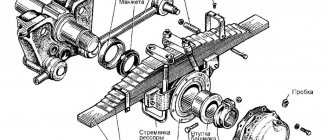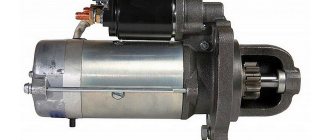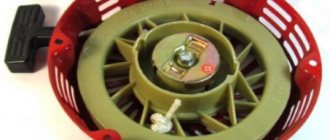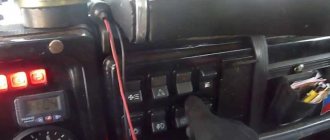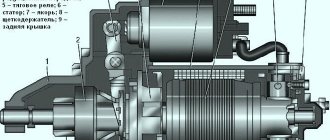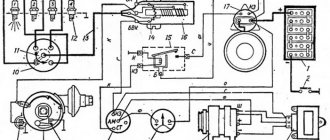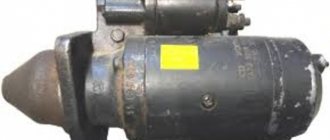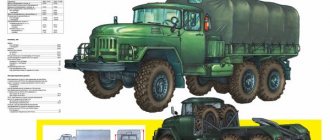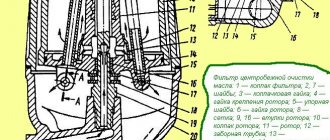Trucks from Naberezhnye Chelny remain quite archaic by modern standards, but in many ways this plays into their hands: if the KamAZ starter does not turn, the driver often copes with the breakdown on his own. Good maintainability and a design that has been studied over the years are definitely one of the strengths of the brand. However, even here an auto electrician may find work: in practice, 24 Volt technical assistance specialists have had cases when a simple fault took a lot of time to find a “floating” defect.
We're leaving! We will quickly find the fault, carry out diagnostics and start the engine. Call! 8-999-999-90-24
| Job | Price |
| Kamaz starter does not turn: departure and diagnostics | 6000 rub. |
| Travel outside the Moscow Ring Road | 50 rub/km |
On new vehicles with imported engines, drivers who are little familiar with the specifics of their design sometimes have difficulties simply because of serious design differences between the electrics and the “classic” KamAZs.
Why does the starter not respond to turning the ignition key?
After turning on the ignition, power from the battery is supplied to the on-board electrical systems and the computer (if equipped). If there is an immobilizer (standard or an installed security system), this occurs only after the tag is recognized. When the key is turned to the start position or the start button is pressed, the contacts of the solenoid relay are closed, resulting in power being supplied directly to the starter. At the same time, the starter overrunning clutch (Bendix) engages with the flywheel crown, setting it in motion and ensuring the engine starts. Often, switching is carried out through an additional starter control relay, which removes the load from the lock.
Ignition switching circuit
If a problem arises at any of the above stages, the car will not start: you turn the ignition key and the starter is silent. As a rule, the reasons for this behavior lie in:
- ignition switch contact group;
- alarm and immobilizer;
- control relay;
- wiring from the control relay to the starter;
- starter solenoid relay.
More information about why the starter does not work with the ignition key can be found in the table.
The starter does not work from the ignition key: reasons
| Problem | Cause of malfunction |
| Starter motor faulty | The electric motor fails due to overheating, short circuits in the windings, wear of the brush assembly, and jamming of the gearbox. |
| The circuit from the ignition switch to the starter solenoid relay is faulty | Wiring break or short circuit. Often occurs after repairs, installation of additional equipment, or as a result of mechanical wear during long-term use. |
| Damage to the ignition switch (deformation of the cylinder) | Deformation due to overheating, which in turn occurs due to poor contact. Damage is also possible due to the mistaken use of an inappropriate key. |
| Electrical malfunction of the ignition switch contact group | The layer of oxides formed on the contacts prevents the flow of current. Also, the contacts may move away due to deformation of the rotary sleeve on which the mating parts are attached. |
| Start blocking by installed alarm | A voltage surge in the on-board network or loss of power (disconnection of a terminal or discharge), failure of a transistor or microrelay responsible for turning on the start line in the base unit of the security system. |
| Immobilizer malfunction/decoding | Voltage drops and sudden loss of power (battery discharged or terminal removed), software failure, failure of microelements. If the immobilizer does not recognize the mark, the starter does not turn after turning the ignition key, and the immobilizer symbol usually lights up or flashes on the indicator panel - an image of a car with a key or lock. |
| Failure of the solenoid relay | Burnout or short circuit of the winding as a result of overheating due to the flow of increased current or being under load for an extended period. The root of all problems is usually oxidation of the internal and external contacts of the solenoid relay. |
| The limit switch for the automatic transmission selector position, the brake pedal for an automatic transmission or the clutch for a manual transmission is faulty | Sensors fail due to mechanical wear, and their wires and terminals can oxidize or fray. Because of this, the ECU does not allow the starter to start. |
| Starter relay failure | If the starter control relay is stuck or shorted, it cannot supply power to the control terminal of the solenoid relay. |
| Poor “+” contact from the battery on the starter | The power contact terminal oxidizes under the influence of moisture and heat. The nut that holds it to the starter stud can come loose due to vibrations. |
| Poor ground contact at the battery terminal, car body or engine | Due to oxidation, the contact of the ground wire deteriorates; the same thing happens when its nut is unscrewed under the influence of vibration. In this case, the passing current may be enough to turn on the on-board network and the ECU, but not enough to drive the starter electric motor. |
How to fix a rattling starter
The method for troubleshooting depends on what is causing the problem. If the starter cannot work normally due to a discharged battery, it is enough to charge it to the required parameters. Typically, charging is carried out with a current of 0.1C, where C is the battery capacity in ampere-hours. At the same time, highly discharged current sources and calcium batteries should be charged with low currents (1-2 A) to at least 25% charge (this parameter is controlled by the density of the electrolyte). The gentle mode will take more time, but will protect the battery from many negative aspects.
Note! Often, when the battery is discharged, car owners try to start the engine “from a tow”. Note that this method is only suitable for the simplest power units, but not for injection engines. Launching the latter “from the pusher” often leads to a failure of the electronic control unit software.
In this case, the ECU begins to behave unpredictably - for example, request permission to start from a disabled immobilizer. The situation can only be corrected by reflashing the “brains”, and this, as you yourself understand, is an additional and completely unjustified expense.
In the case where the cracking of the solenoid relay occurs due to poor contact with the vehicle ground, it is enough to simply restore the electrical connection. To avoid problems in the future, it is recommended to remove the tire that connects the engine to the body and clean the contact pads with sandpaper. A thin layer of technical Vaseline or VD-40 universal lubricant will help prevent their oxidation.
What to do if the starter does not turn the engine from the ignition switch
If when you turn the ignition key the car does not start, and nothing happens at all, in some cases you can correct the situation by supplying power to the starter, bypassing the lock. This solution is suitable for cases where the electric motor itself and the solenoid relay are in good working order. In this case, you need to proceed according to the following algorithm:
Control wire terminal
- Turn on neutral gear and ignition.
- Find two terminals on the starter: a thick power wire from the battery positive and a thin control wire from the control relay.
- Using a metal object (screwdriver, key, wire), close the power and control contacts.
- After the starter operates and the engine starts, immediately open the contacts.
An alternative to the same method is to supply power to the starter control terminal directly from the positive terminal of the battery. This can be done using any insulated wire, for example from a cigarette lighter wire kit.
The lack of response of the starter to direct power supply indicates its breakdown, failure of the electric motor or the solenoid relay. To diagnose the starter, you need to disassemble the starting unit, inspect the brush assembly, armature and stator windings. This is not easy to do in the field and without a multimeter, so you need to push the car and get to the garage or service station.
When the starter turns directly, but not from the key, then the starter itself is fully operational, and the problem lies in the electrical circuit from the key to the starter. To determine the location of the breakdown, you need to follow the instructions given below.
KamAZ truck crane does not start
Below is one of the cases from our repair practice. A truck crane based on KAMAZ Euro 3, manufactured in 2008, located at the Kuntsevsky car market. The starter turns, the car does not start. It stopped starting without any reason, the driver told us. Upon arrival, the technician checked the positives on the electronic engine control unit (MS6.1) and discovered a lack of power. I’ll say right away that this is a very common malfunction and that’s why we fix such breakdowns right away. It took the auto electrician exactly one hour to return the truck crane to working condition. The customer was very grateful to us for our efficiency and, to confirm this, generously paid for the repairs.
Frequent malfunctions on popular cars
In most cases, the starter does not turn when the ignition key is turned due to oxidation and mechanical damage to the wiring. If there is poor contact with the “+” terminal of the battery, the control relay or ground, the starter does not receive enough current to crank the engine . Therefore, first of all, you need to look at the contacts in the engine compartment and check for voltage at the terminals with a tester. The most common malfunctions of specific car models, due to which the starter does not respond to the ignition key in the table.
| Why does the starter not work from the ignition key on popular car models? | |
| Auto | Weakness |
| VAZ 2110, 2111, 2112 | Wires of the central locking and ignition switch, which melt due to power surges. |
| VAZ 2108, 2109, 21099, 2113, 2114, 2115 (Lada Samara) | Oxidizing contacts of the control relay located in the engine compartment above the VUT, as well as the wiring extending from it. |
| VAZ 2101, 2102, 2103, 2104, 2105, 2106, 2107 (Classic) | The contact “nickels” of the solenoid relay often burn or oxidize. The contact group of the ignition switch fails. On later models, for example, 2107, problems with the control relay are similar to Samara (see above). |
| Niva | On old Nivas (before 21213), the ignition switch contacts burn and oxidize. On newer ones (after 21214), the starter control relay, located under the hood near the brake fluid reservoir, often fails. There is a drainage tube located nearby that drains water from under the glass, moisture from which gets onto the relay, which leads to oxidation of its contacts. |
| Lada Priora | Immobilizer problems due to which it does not see the key. |
| Lada Kalina, Lada Granta | Failure of the immobilizer, blocking the start, malfunctions in the contact group of the ignition switch and failure of the additional starter relay K3 in the fuse block. |
| UAZ | Malfunction of the 5-pin starter control relay and solenoid relay. |
| Gazelle | Poor contact of wires and failure of the starter relay. |
| Peugeot 307 | Solenoid relay fuse F8 blows, poor ground contact. |
| Kia Sid | The limit switch of the automatic transmission selector, which determines the P and N positions, is faulty. There may be poor contact at the starter terminals or at the point where the ground wire is attached to the body. |
Combined boost pressure/intake manifold air temperature sensor
The air pressure and temperature sensors in the intake manifold are combined into a single unit.
The sensor is installed on top of the engine intake pipe.
If the combination sensor is faulty, the controller limits the boost pressure and engine power is reduced.
Disconnect the negative terminal of the battery
Squeeze the wire block clamp
Disconnect the wire block from the sensor
Unscrew the screw securing the combined sensor.
Remove the sensor from the engine by pulling it vertically upward.
When removing the sensor, be careful not to damage the O-ring and plastic guard surrounding the sensor tip. Do not use the lever to avoid damaging the plastic guard.
We check the wiring harness connector and the combined sensor for the following defects:
— cracks or damage to the body;
— missing or damaged connector seals;
— dirt, foreign particles or moisture on the connector contacts;
- corroded, bent, broken, dented or extended connector pins.
We check the sensor tip for the absence of soot, deposits, and carbon deposits.
If necessary, remove soot using compressed air.
Do not replace the sensor due to soot on it.
We install the sensor on the engine. Tighten the bolt to a torque of 6 Nm.
Answers to frequently asked questions
How can you tell if the starter relay is not working?
To determine whether the starter relay is working, apply power from the positive terminal of the battery directly to the control contact of the relay. After this, a click should sound; if it is faulty, there will be no sounds.
How to check whether the starter is working or not?
To check the serviceability of the starter itself, you need to apply current to it directly by connecting the power wires of the retractor relay (thick wire from the battery) and the electric motor (stud with a thick wire from the retractor to the starter). A working starter should start moving.
What to do if the starter does not work after turning the ignition key?
First, make sure there is voltage at the battery terminals. If you don’t have a tester, this can be done using a 12 V lamp. Then try to apply voltage directly to the starter: use a screwdriver to close the pin to which the wire from the battery goes and the control contact located nearby. If there is no reaction, check the quality of the contacts of the terminals on the battery, the ground contacts (with the body and the engine) and the contacts of the starter itself by cleaning and tightening the terminals. If the battery is discharged or the starter is faulty, you need to start the car with a pusher (manual transmission) or tow it to the repair site.
Why does the starter not work with the ignition key?
The main reasons why the car does not respond to the ignition key:
- control relay failure;
- breakdown of the ignition switch/contact group;
- wire break or short circuit;
- problems with the anti-theft system (alarm, immobilizer);
- breakage of the solenoid relay;
- starter motor failure.
If the starter turns directly, but not from the key, then the last two problems can be eliminated.
History from the archives
The car was quite new in years; a modern Cummins diesel engine was already used. But, nevertheless, it refused to start after a week of parking: all the lamps went out synchronously when trying to turn on the starter, the starter made a single click and “faded out.” On these cars, it is convenient that the starter relay is mounted on the starter itself next to the retractor: you can immediately check both it and the retractor with short jumpers to “plus”. And the relay itself is much more reliable than a regular KAMAZ one.
However, here the problem was clearly massive, and a thick cable stretched across the “crocodiles” confirmed this: the machine started up normally. The technician examined the standard power ground wiring, but did not find any defects - neither burnt out ground switch, nor oxidized terminals. However, with the standard cable the car refused to start.
Only upon closer inspection was a slight damage to the insulation discovered - seemingly not affecting serviceability, and the car had clearly been driven for such a long time. But over time, water saturated with de-icing reagents inevitably entered the cable veins, and it dispersed through the veins inside the cable, as if through capillaries. As a result, the cable literally rotted from the inside; its resistance caused such voltage drops under load that the moment the starter was turned on, the entire electrical wiring went out.
Types and design of electric starter relay
There are three types of starter relay:
- blocking (preventing the device from starting when the engine is running);
- unloading (converting lower currents into stable 12 V);
- retractor (traction), which is attached directly to the starter.
The first two are certainly important, but they are not installed on every car, unlike the “traction” one, without which the engine will not start.
The traction electromechanical relay is responsible for:
- The bendix is thrown into engagement with the flywheel.
- Closing and holding the bridge between the “plus” of the relay and the starter.
- Stable power supply to the brush assembly of the electric starter.
- Timely shutdown of the trigger mechanism.
Scheme of the starter retractor relay
Inside, it is arranged simply: under the metal case there is a two-winding coil with a core. On the one hand, the body has a protruding rod (the pulling end of the armature), on the other, an ebonite cover with three terminals (2 powerful contact bolts and one “pin”). The lower bolt is connected to the plus of the electric starter by a power wire (oblique). The armature - a metal core - “walks” longitudinally inside two windings (coils): “retracting” (VO) and “holding” (CU). When retracted, it presses on a movable electrode, at the end of which a spring-loaded copper contact plate is attached. At the end of the armature (core) stroke, the plate is pressed against the “nickels” of the bolts, closing a short circuit - from one to the other, and then to the electric starter brushes.
The edge of the core is connected to a fork lever that moves the Bendix gear forward. In the non-working position, it protrudes far from the body, and when current is supplied to the pulling coil, it goes under it, “pulling” the upper edge of the “fork” behind it. Swinging on the axis, its lower edge moves forward - carrying out, through the driving clutch, the Bendix (gear with a freewheel) into engagement with the teeth on the flywheel crown. When this happens, a metallic knocking or clicking sound is heard.
Diagnostic specifics
The KamAZ engine can stall for various reasons, so you need to take into account the typical malfunctions for a specific car model. In some cases, clogs may occur due to low quality fuel, requiring professional cleaning.
In addition, each type of car requires special attention. For example, the battery of injection vehicles cannot be disconnected while the engine is running, you cannot perform actions with the batteries yourself, disconnect the ground on the car, or actively use charging and starting devices. When using diesel fuel, you need to remember that it is vulnerable to low air temperatures, as a result of which diesel sometimes freezes. The simplest are cars with gasoline engines, since they require a minimum of maintenance and are undemanding in terms of fuel and operating conditions.
KamAZ is also vulnerable to water, since its entry into the injector will lead to acidified contacts and breakdown of the technical system. To prevent unwanted problems, it is advisable to promptly change fuel filters and fill only high-quality fuel.
Working principle of VR
A constant plus is supplied from the battery to the upper power bolt of the “traction” bolt. In the free state, the contact plate does not touch the “nickels” of the power bolts in the cover. Both windings – the pull winding (VO) and the holding winding (CU), are connected with one terminal to a small “control” terminal, which receives the starting pulse from the ignition key (plus). The second output - a more powerful VO - goes to the jumper with the lower power bolt (plus of the starter electric motor), and the OU - to the “ground” (housing).
Starter connection diagram
As soon as the ignition key closes the power supply circuit to the VO, the current in it will create a magnetic field, under the influence of which the core will move inside the housing, push the bendix forward, and press the plate to the terminals. The plate will create a “short path” for high voltage current - from the top bolt, to the bottom and to the starter brushes. When the current flows through it, the “minus” disappears from the traction winding. Now only the holding one starts working, which is still energized (and will be as long as the ignition key remains in the “Start” position).
Why does the relay click but the starter does not turn the engine?
A single click “indicates” that the retractor winding is working, the bendix is “out.” If after this the gear does not turn, either the car starter itself is faulty, or the freewheel has failed. If the retractor often “shoots” with the bendix, it means that the problem is in the holding coil, which is unable to “pick up” the core when the pulling coil has already turned off.
In order for the car engine to start, the Bendix needs to spin with good force, while being in clear engagement with the teeth of the flywheel ring.
The force is fully provided by the electric starter motor, but the relay “opens the way” for it, so the stable operation of the devices is interconnected. If the starter clicks, the problem is definitely not in the retractor winding.
- The battery is dead or the terminals are not tightened.
- There is no stable “mass” for VO.
- Starter armature short circuit.
- Loss of conductivity on nickels.
- The brushes crumbled.
- The general “mass” (battery) has come off.
To quickly check one problem unit - with a screwdriver or a wrench - tap 2-3 times (shortly, sharply, but not hard) on the solenoid relay body, closer to the cover. Loss of conductivity often occurs from misalignment of the plate that closes the heels. This will force her to return to her place.
Price list for engine overhaul
Overhaul of an engine with a volume of up to 15 liters inclusive 10,000 rubles/liter Overhaul of an engine with a volume of 19 liters or more 19,000 rubles/liter
Attention! 1. The price does not include the cost of spare parts
2. The final price for repairing a truck engine is agreed with the customer after troubleshooting the engine!
3. The cost of troubleshooting is included in the cost of major repairs.
The cost of troubleshooting is 50% of the price for major repairs
Troubleshooting of an engine with a volume of up to 15 liters inclusive 5,000 rubles/liter
Troubleshooting of an engine with a volume of 19 liters or more RUB 9,500/liter
The cost of work for the overhaul of Cummins engines for low and medium power engines (up to 15 liters) consists of:
- Engine disassembly from 350 rub/liter
- Washing and cleaning of engine parts and components from RUB 1,650/liter
- Troubleshooting of engine parts and components from RUB 3,000/liter (when carrying out troubleshooting outside of repairs, the cost is indicated in the price list)
- Repair of engine components (using new spare parts) from RUB 2,300/liter
- Engine assembly (using new spare parts) from RUB 2,700/liter
- Starting the engine (commissioning work at the contractor’s premises) -
- Repair of diesel fuel pumps
- Engine painting is possible.
Additional work is carried out by additional agreement of the parties and may include installation/dismantling of the engine and transportation of the engine from/to the Customer’s site. For high-power engines, work is carried out only by agreement of the parties in the manner approved by the parties. The estimated cost of the work is given in the price list. Troubleshooting work “down to the bolt” is possible.
It is no secret that a prudent owner of equipment wants it to work for many years, and, preferably, without outside interference. Unfortunately, the laws of nature cannot be ignored or abolished. Over time, repair of diesel engines in Tula and Kaluga becomes an urgent problem for the owner of such an engine.
How to protect your Cummins?
The reliability of Cummins diesels, as well as their “whims” in service, have long become the talk of the town. Haven't done scheduled maintenance, are you saving on oil and fuel? Please note that malfunctions occur quite quickly and consistently!
So, repair of a truck engine in Tula, Kaluga may be necessary:
- in case of untimely replacement of fuel, air and/or oil filters;
- in case of untimely oil change and its “quality”;
- when impurities enter the fuel system that should not be in diesel fuel (water, paraffin, dirt, etc.).
A malfunction in which the retractor has nothing to do with it
The situation when the starter turns, but the engagement between the teeth of the Bendix gear and the flywheel ring does not work, happens often. Especially after repairs with the replacement of the bendix, or in cars with over two hundred kilometers.
Worn bendix gear
Despite the fact that a click was heard, signaling that the bendix had come out, the length of its stroke was not enough for full contact, and the motor would spin the clutch idle. With this malfunction, you can hear the characteristic buzz of a working starter, vigorous, but ineffective. Neither from the second nor from the tenth start will it be possible to get rid of the problem - you need to remove the electric starter, check the pushing force of the “traction”, the condition of the teeth on the bendix and the starter ring of the flywheel.
Possible malfunctions of the ignition system
The ignition system is checked if the starter turns and gasoline is supplied to the engine, but the engine cannot be started. Spark plugs and high-voltage wires are excluded from the list, since these units cannot break down at the same time. If KamAZ does not start, the reasons can only be determined through diagnostics.
Important! In the most difficult cases, the problem may be caused by a blown fuse, power failure, relay failure, contact damage, or engine ECU malfunction.
In this case, comprehensive diagnostics may be required, the results of which will determine the condition of the vehicle. You can also read about Wheel alignment on KamAZ - How to do it right.
How to check the solenoid relay
You can check the VR in two ways - without removing it from the car and after removing it together with the starter. If you suspect that the signal from the lock is lost somewhere in the circuit, first carry out a regular test on the car, then, based on the results, the unit can be removed and checked more accurately - with a multimeter.
Check without removing from the car:
- Put the car on the handbrake, make sure it is in neutral gear.
- Turn on the ignition and leave the key in the lock.
- Remove the connector (thin wire) from the control terminal BP.
- Using a screwdriver, close the terminal with the upper power bolt (plus from the battery).
If after this the car starts, the problem is in the control circuit (the pulse from the lock does not reach the terminal). If the starter continues to click but does not turn, check the devices separately. To do this, the “traction” needs to be disconnected from the starter housing (it’s easier to remove them from the car together, and then separate them).
- Turn the multimeter into audible dialing mode.
- Connect one probe of the device to the control terminal.
- The second one has a lower power bolt (terminal for brushes).
- If there is a signal, the pull-in winding is intact.
- Leaving the first probe on the terminal, attach the second one to the body.
- If there is a signal, the holding coil is also intact.
- Install the device vertically, on the anchor, with the terminals facing up.
- Place the feeler gauges on the bolts - one on the top, one on the bottom.
- Press the relay, pressing the armature all the way.
- If there is sound, the power terminals are closed correctly, the plate is working.
- If there is no sound, but the display displays numbers, it does not work. The reason is external resistance.
Checking the solenoid relay with a multimeter
If at least one breakdown is detected, the part is replaced with a new one or a known good one. If both coils are intact, and the plate closes the “nickels” normally, all that remains is to test the force with which the spare part moves the armature plunger. To do this, first measure the free play of the plunger by inserting the relay into place in the housing until the loop tightly touches the fork lever, and use a ruler to measure the distance between the electric starter housing and the retractor itself. Pull out the part, push the plunger in until it touches the spring, now set the resulting distance on the plunger from the edge of the body. Mark (with marker or awl).
From the equipment you will need: a charged battery, three pieces of wire with a cross-section of 2 squares, with alligator clips and a plug for the control terminal (connector 50).
- Fix two wires with one end to the “ground” (body) of the part.
- Connect one of these wires to the negative terminal of the battery.
- Place the third wire with the plug on the positive battery.
- With one hand, press the part to the surface, “squeezing” the plunger to the mark.
- Place the plug on connector 50.
- Touch the end of the free wire (from the housing) to the lower power bolt.
- If the core overcomes the resistance and retracts, there is no problem, the retractor relay is working.
To evaluate the force, you need to securely fix the device (by the loop on the anchor) on a flat, solid base. The surface should not conduct current - for example, a wooden or cardboard-covered table.
Malfunctions of fuel injection pump KAMAZ 740, fuel injection pump KAMAZ 4310
If you find any problems with the KAMAZ engine, you should pay attention to the operation of the power system. During a more detailed inspection, diagnostics of fuel equipment is carried out, guided by the standards and operating recommendations specified in the technical characteristics of the KAMAZ injection pump.
Symptoms of malfunction of fuel injection pump KAMAZ 740, fuel injection pump KAMAZ 4310
Malfunctions of fuel pumps and regulators manifest themselves in a violation of adjustment due to wear of parts, which results in the occurrence of extraneous noise, overheating and fuel leakage.
The main reason for the malfunction of the fuel pump is wear of its parts, weakening of the tightness in the fits, increased gaps in the moving joints, violation of the location of the parts, and deposits on the surface of the parts in the form of dirt and carbon deposits.
The consequence of pump malfunctions can be a decrease in the supply of fuel in the required quantity and uneven supply. Failure to properly supply fuel is usually caused by wear of plunger pairs, pump discharge valves, plunger drivers, rack clamps, rack teeth and bushing gears, and clogging of injectors. Such malfunctions lead to a decrease in engine power and efficiency.
Uneven supply of fuel to the engine cylinders will lead not only to unstable operation at low speeds, but also to interruptions in the operation of individual cylinders, which will be accompanied by vibration of the engine block.
Fuel injection pump malfunctions include uneven start of injection and delay in injection timing of a multi-section pump, which occurs due to wear of the pusher adjusting bolt, roller axis, pusher and roller housing, ball bearings, as well as wear of the cam shaft.
Wear of plunger pairs and injection valves significantly affects the change in the fuel injection advance angle.
- The KAMAZ engine does not start or starts poorly;
- Uneven operation of the KAMAZ engine;
- During operation, noises and knocking noises from the KAMAZ engine occur.
The main reasons why the KAMAZ engine does not start:
- There is no fuel in the fuel tank;
- Presence of air in the fuel system;
- Clogged or contaminated fuel lines of the KAMAZ power supply system;
- The fuel has thickened due to low temperatures;
- Malfunctions of the high pressure fuel pump (injection pump malfunctions)
- Clogged fuel filters.
To determine the malfunction of the power system, you should follow the chain from less expensive and costly faults to more costly ones, taking into account the flow chart for repairing the power system.
Actions that can be taken to troubleshoot problems with the power system of KAMAZ 740, KAMAZ 4310:
- Fill the fuel tank with fuel;
- Bleed the system, remove air and eliminate leaks;
- Blow out the fuel lines, replace clogged filter elements;
- Check the high pressure fuel pump (KAMAZ injection pump), if necessary, repair the KAMAZ injection pump.
The KAMAZ 740 engine does not develop full power
- Replace the air filter;
- Adjust the fuel supply angle;
- Clean the injectors, adjust the injectors;
- Repair the injection pump;
- Check the operation of the KAMAZ injection pump.
Uneven operation of the KAMAZ 740, KAMAZ 4310 can be caused by loss of functionality of individual injectors, a malfunction of the high-pressure fuel pump or its regulator. Damaged injectors must be replaced, and the injection pump, as a more expensive part, is checked on a fuel stand and repaired if necessary.
Knocks in the engine KAMAZ 740, KAMAZ 4310
Knocks in the KamAZ engine may indicate that it is necessary to adjust the fuel supply angle or replace the KAMAZ fuel injection pump rack.
Troubleshooting methods
If the check reveals a short circuit, it is easier to immediately replace the part with a new one. To restore normal conductivity on the “nickels” and correct a break in the holding winding at the fastening point, disassemble the spare part, desolder the terminals, clean the copper from oxide, reassemble, and tighten the fasteners.
Depending on the manufacturer and year of manufacture, the solenoid relay comes with a detachable housing (the cover of the power contacts is secured with screws) and with a one-piece housing (rolled into the metal of the housing). Diagnostics of both types of parts can be carried out without opening them, but there is a problem with repairs: with “one-piece” parts, the body is very difficult to assemble neatly and can easily be damaged during assembly. A cracked cover is unsuitable for further use. If you have little experience in fine work with electromechanical devices, it is easier to purchase a new, known working relay.
Source
